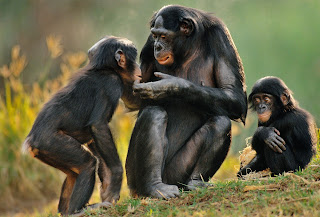
The bonobo is a primate that is sometimes referred to as a “dwarf chimpanzee” due to its resemblance to chimps. Although they appear to be the same species, bonobos and chimps were classified as separate species at the beginning of the twentieth century. The bonobo can only be found in the Democratic Republic of the Congo, in the dense, swampy rainforests of the Zaire river basin. The bonobo is listed as an endangered species due to rapid habitat loss, hunting, and civil wars. According to the most recent estimates, there are approximately 10,000 bonobos left in the wild.
Despite the name “dwarf chimpanzee,” bonobo and chimp are the same size. Bonobo can grow to be between 29 and 35 inches tall and weigh between 55 and 110 pounds. Males are physically larger than females.
Aside from chimps, the bonobo is one of the closest relatives to humans, with 98 percent genetic similarity. The bonobo is an extremely intelligent and emotional animal.
Bonobo can understand language, communicate with others, play musical instruments, and use a variety of tools.
The skeleton of a bonobo is upright, with long legs and narrow shoulders. It walks on two legs (on two legs).
The majority of a bonobo’s diet consists of plants. They typically consume fruits, leaves, honey, and seeds. Insects, worms, eggs, and crustaceans appear on the menu from time to time. Small mammals are rarely hunted and eaten by bonobos.
Bonobos are diurnal (they are active during the day). They spend a portion of their lives on the ground and the remainder in the trees.
The thumb of a bonobo, like that of many other primates, is opposed to the other fingers. This feature enables bonobo to grip the branches and use various tools.
Bonobos live in large groups with one alpha male, a large number of females, and their offspring. A group of bonobos is known as a “troop,” and it can have up to 100 members.
Bonobo, unlike chimps, coexist with all members of their group. Fights and disagreements are uncommon in nature. Life in the group protects against predators.
Crocodiles and humans are the main predators of bonobos.
A group of bonobos spend the night in tree nests. When they are gathered in a group, they communicate by making high-pitched barking sounds.
The bonobo has no set mating season. Females reach sexual maturity between the ages of 13 and 14 years. After that, they will have children every 5 to 6 years. During her lifetime, each female has between 5 and 7 children.
Pregnancy lasts 8 months and results in a single child. The bond between mother and child is strong. Mother looks after the young bonobo, who ranges in age from 3 to 6 years.
Young males rely on their mothers more than young females. Even when they reach sexual maturity, they will remain in the troop. Females will defect and join another unit.
In captivity, the average lifespan of a bonobo is 40 years.









